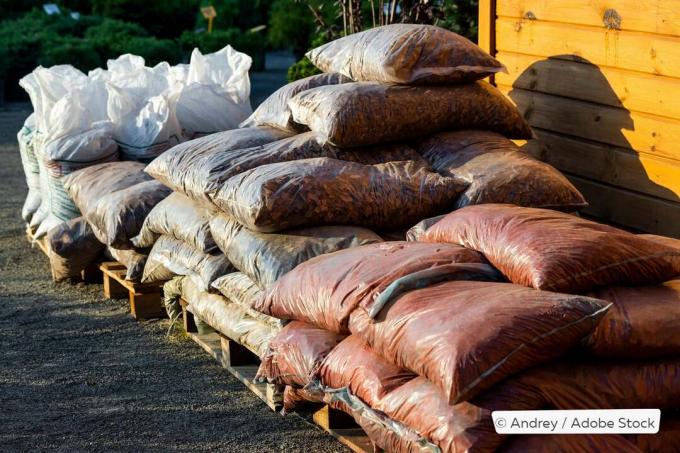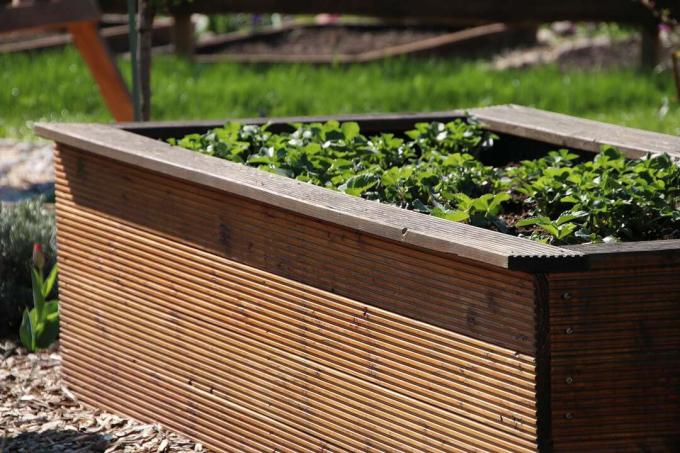
Before fine, nutrient-rich soil comes on top, the raised bed requires coarser filling material. In this respect, wood chips and bark mulch are similar and seem to be interchangeable. But what effect do they have in the bed?
In a nutshell
- Wood chips good filling material for raised beds
- for the bottom layer and as an admixture in other layers
- Bark mulch conditionally suitable
- only in the lower layers as an addition
- not recommended for raised vegetable beds
Table of contents
- differences
- Pros and cons of wood chips
- Pros and cons of bark mulch
- Wood chips or bark mulch?
- Wood chips in the raised bed
- Bark mulch in the raised bed
- frequently asked Questions
differences
Wood chips, also known as wood chips and woodchips, are made of 100% wood. They occur in forestry and the wood-processing industry when wood residues or Forest wood that cannot be processed in any other way is mechanically shredded. Bark mulch is also of natural origin, but consists of crushed tree bark, mostly from conifers. Both wood chips and bark mulch are available in different grain sizes.

Pros and cons of wood chips
This Wood chips offer advantages in the raised bed:
- soil temperature regulation
- good ventilation
- Water can drain away, waterlogging is prevented
- slow decomposition, ideal for years of use
- cheap price
- may fall in your own garden
A notice: If the wood chips come from untreated wood and if they are filled correctly in the raised bed, there are no disadvantages to fear.
Pros and cons of bark mulch
As mulching material bark mulch looks back on a long, successful period of use in simple flower beds. It keeps the soil moist, provides nutrients and suppresses weeds. As a filling for a raised bed, the material cannot shine with these tried-and-tested advantages, as it is exposed to other challenges or must fulfill other functions. Unfortunately, here are the disadvantages:
- can store too much water (wetness problem)
- binds the nutrient nitrogen
- compacts easily because of many fine particles
- rots too fast
- lowers the pH
Tip: The binding of nitrogen, an important nutrient for plants, can be compensated for by adding horn shavings.
Wood chips or bark mulch?
The previously mentioned advantages of wood chips and the disadvantages of bark mulch clearly speak in favor of wood chips as filling material for a raised bed. Even a look at the costs does not change anything, because wood chips are usually cheaper than bark mulch. Bark mulch can be used as a filling material, but only as a supplement and in small quantities.

A notice: Bark mulch and woodchips are available at hardware stores or online. It's also worth checking with a sawmill nearby.
Wood chips in the raised bed
Coarse wood chips, which are made from natural wood, can be used very well for the bottom layer of a raised bed. This bottom layer can consist entirely of wood chips, but may also contain small branches and twigs. the max The filling limit is around 40% of the internal height. You can also add finer wood chips to the filling material for other layers.
Bark mulch in the raised bed
Bark mulch should only be used for the bottom layer in the raised bed. For middle layers, it may only be used as a restrained admixture, even if it was not used for the bottom layer. In the Filling a raised bed with bark mulch the following points must also be observed:
- unsuitable for low raised beds
- If possible, do not use for vegetable beds
- mix with other filling materials
- never use only bark mulch
- use tested RAL quality
- Bark mulch must be natural
- no foreign substances, no dyes
- use coarser grit

Tip: Bark mulch is best suited for raised beds in which mainly flowers that tolerate slightly acidic soil grow. Then also as a typical mulch layer after planting.
frequently asked Questions
Yes, that is possible. You need suitable wood material for this, for example collected forest wood or cuttings from the garden. You should also have a powerful shredder available. It is best to use bare branches without a lot of greenery, as this will impair the ventilation of the raised bed after it has rotted.
It is best to fill the raised bed in autumn. On warmer days, the filling material can start to "work", i. H. to rot and release some nutrients. In addition, the time until spring ensures that the filling material can settle. Soil can then be refilled before planting. Alternatively, filling in the spring is also possible.
For the bottom layer in the raised bed, you should only mix bark mulch with coarse filling material. Depending on availability, use branches, twigs, wood chips, larger pebbles, expanded clay, pieces of clay.
Wood chips and bark mulch usually form the bottom layer in the raised bed. Therefore, the old material cannot simply be exchanged for new ones. If the fill level drops due to rotting, only normal soil is refilled. That has to be after about six to seven years Raised bed to be completely refilled. Only then can wood chips or bark mulch be put in again.



